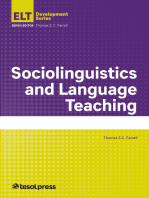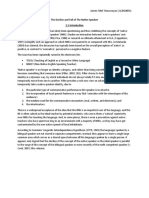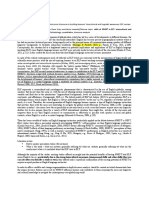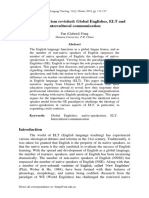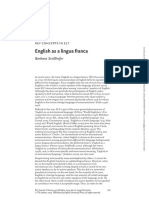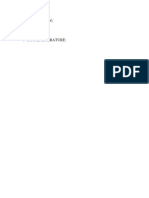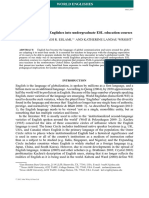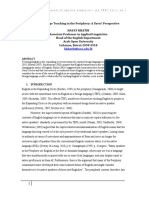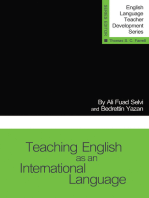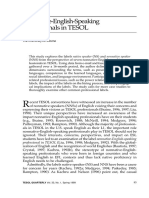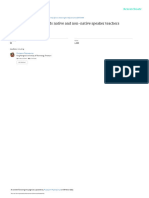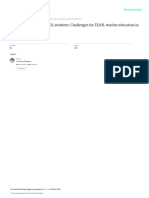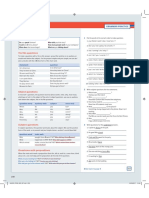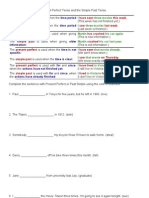0 ratings0% found this document useful (0 votes)
34 viewsSelvi 2009 The Non Native Speaker Teacher
Selvi 2009 The Non Native Speaker Teacher
Uploaded by
gabar.coalThis document discusses the conceptualization and treatment of non-native English speaking teachers (NNESTs) in the field of English language teaching (ELT). It notes that NNESTs have traditionally been viewed as defective communicators compared to an idealized native speaker. However, the ownership of English is now understood to be shared among all speakers regardless of nativeness. Nevertheless, NNESTs are often accorded lower professional status than native English speaking teachers (NESTs). The document argues that the ELT field needs to move beyond using the native speaker as the sole benchmark and embrace the strengths of both NESTs and NNESTs to foster more appropriate English learning opportunities.
Copyright:
© All Rights Reserved
Available Formats
Download as PDF, TXT or read online from Scribd
Selvi 2009 The Non Native Speaker Teacher
Selvi 2009 The Non Native Speaker Teacher
Uploaded by
gabar.coal0 ratings0% found this document useful (0 votes)
34 views3 pagesThis document discusses the conceptualization and treatment of non-native English speaking teachers (NNESTs) in the field of English language teaching (ELT). It notes that NNESTs have traditionally been viewed as defective communicators compared to an idealized native speaker. However, the ownership of English is now understood to be shared among all speakers regardless of nativeness. Nevertheless, NNESTs are often accorded lower professional status than native English speaking teachers (NESTs). The document argues that the ELT field needs to move beyond using the native speaker as the sole benchmark and embrace the strengths of both NESTs and NNESTs to foster more appropriate English learning opportunities.
Original Title
Selvi 2009 the Non Native Speaker Teacher
Copyright
© © All Rights Reserved
Available Formats
PDF, TXT or read online from Scribd
Share this document
Did you find this document useful?
Is this content inappropriate?
This document discusses the conceptualization and treatment of non-native English speaking teachers (NNESTs) in the field of English language teaching (ELT). It notes that NNESTs have traditionally been viewed as defective communicators compared to an idealized native speaker. However, the ownership of English is now understood to be shared among all speakers regardless of nativeness. Nevertheless, NNESTs are often accorded lower professional status than native English speaking teachers (NESTs). The document argues that the ELT field needs to move beyond using the native speaker as the sole benchmark and embrace the strengths of both NESTs and NNESTs to foster more appropriate English learning opportunities.
Copyright:
© All Rights Reserved
Available Formats
Download as PDF, TXT or read online from Scribd
Download as pdf or txt
0 ratings0% found this document useful (0 votes)
34 views3 pagesSelvi 2009 The Non Native Speaker Teacher
Selvi 2009 The Non Native Speaker Teacher
Uploaded by
gabar.coalThis document discusses the conceptualization and treatment of non-native English speaking teachers (NNESTs) in the field of English language teaching (ELT). It notes that NNESTs have traditionally been viewed as defective communicators compared to an idealized native speaker. However, the ownership of English is now understood to be shared among all speakers regardless of nativeness. Nevertheless, NNESTs are often accorded lower professional status than native English speaking teachers (NESTs). The document argues that the ELT field needs to move beyond using the native speaker as the sole benchmark and embrace the strengths of both NESTs and NNESTs to foster more appropriate English learning opportunities.
Copyright:
© All Rights Reserved
Available Formats
Download as PDF, TXT or read online from Scribd
Download as pdf or txt
You are on page 1of 3
key concepts in e l t
The non-native speaker teacher
Ali Fuad Selvi
Downloaded from https://academic.oup.com/eltj/article/65/2/187/528735 by guest on 31 October 2023
‘Non-native English-speaking teachers’ (NNESTs) have tended to be
conceptualized within E LT along the same lines as NNS in general. The
second language acquisition literature traditionally ‘elevates an idealized
‘‘native’’ speaker above a stereotypicalized ‘‘nonnative’’, while viewing the
latter as a defective communicator, limited by an underdeveloped
communicative competence’ (Firth and Wagner 1997: 285). The resulting
(in)competence dichotomy positions the NNS/NNEST as a deficient or less-
than-native speaker (cf. ‘near-native’, Valdes 1998). In an attempt to
solve this problem, a number of alternative terms have been suggested,
for example ‘proficient user’ (Paikeday 1985), ‘language expert’ (Rampton
1990), ‘English-using speech fellowship’ (Kachru 1992), and
‘multicompetent speaker’ (Cook 1999). However, the field is still a long way
from reaching a consensus about whether to adopt any of these labels.
Debate about this issue is particularly important in the realm of teaching
and learning English as an International Language (Jenkins 2000; McKay
2002). In this context, NNS are estimated to outnumber their ‘NS’
counterparts by three to one (Crystal 2003), the ownership of English is
shared by all its speakers, regardless of their ‘nativeness’ (Widdowson
1994), and 80 per cent of English language teachers worldwide are thought
to be NNESTs (Canagarajah 2005). Nevertheless, N N E S Ts are often
accorded lower professional status than ‘native English-speaking teachers’
(NESTs) (Mahboob 2010). It is widely accepted that the presence of ‘native
speakerism’ (Holliday 2005) of this kind in the English language teaching
profession leads to ‘unprofessional favouritism in institutions, publishing
houses, and government agencies’ (Medgyes 2001: 433), frequently also
resulting in unfair employment discrimination (Selvi 2010).
Phillipson (1992: 185) refers to such unethical treatment of qualified
N N E S Ts as a result of the ‘native speaker fallacy’: a prevalent assumption
that ‘the ideal teacher of English is a NS’ (ibid.). Using the NS as
a benchmark for teaching employment in this way can cause NNESTs to
suffer from the ‘I-am-not-a-native-speaker’ (Suarez 2000) or ‘impostor’
syndrome (Bernat 2009), leading to negative consequences for their
teacher persona, self-esteem, and thus their in-class performance as well.
Consequently, the global E LT enterprise has been criticized for positioning
the NS as the ideal English teacher and thereby creating a false dichotomy
between N E S Ts and NNESTs (Moussu and Llurda 2008). The need to go
beyond the NS as a benchmark in English language learning and teaching
E LT Journal Volume 65/2 April 2011; doi:10.1093/elt/ccq092 187
ª The Author 2011. Published by Oxford University Press; all rights reserved.
has therefore been widely argued for in the field (Braine 1999, 2010
Mahboob op.cit.).
Subscribing to the dominant ‘either/or discourse’ (i.e. NEST or N N E S T) in
this area has also been seen as problematic because it attempts to establish
a direct causal relationship between language proficiency and pedagogical
practices (Braine op.cit.). Such discriminatory attitudes have led the US
TESOL organization to adopt two ‘position statements’ (TESOL 1992,
2006) opposing such discriminatory practices. As a result of such
initiatives, the E LT field is now moving towards a more encompassing
‘both/and discourse’ (i.e. NEST and NN EST) that embraces the strengths
and limitations of both teacher populations in various teaching settings
Downloaded from https://academic.oup.com/eltj/article/65/2/187/528735 by guest on 31 October 2023
(Matsuda and Matsuda 2001). This reconceptualization enables
cooperation and collaboration that can foster more educationally,
contextually, and socially appropriate English language learning
opportunities (Mahboob op.cit.). As a result, on a micro level, learners of
English as an international language can gain access to a wider
sociolinguistic and intercultural repertoire (McKay op.cit.). On a macro
level, it lends further support to the establishment of a professional milieu
that ‘welcome[s] ethnic, racial, cultural, religious, and linguistic diversity’
(Selvi 2009: 51).
References Jenkins, J. 2000. The Phonology of English as an
Bernat, E. 2009. ‘Towards a pedagogy of International Language. Oxford, UK: Oxford
empowerment: the case of ‘‘impostor University Press.
syndrome’’ among pre-service non-native Kachru, B. 1992. The Other Tongue: English
speaker teachers in T ES O L’. English Language across Cultures. Urbana, IL: University of Illinois
Teacher Education and Development Press.
Journal 11: 1–11 Available at http://www.elted.net/ McKay, S. L. 2002. Teaching English as an
issues/volume-11/1%20Bernat.pdf Bernat.pdf International Language. Oxford, UK: Oxford
(accessed on 4 July 2010). University Press.
Braine, G. 1999. Non-native Educators in English Mahboob, A. 2010. The NN EST Lens: Nonnative
Language Teaching. Mahwah, NJ: Erlbaum. English Speakers in T E S O L. Newcastle, UK:
Braine, G. 2010. Nonnative Speaker English Teachers: Cambridge Scholars Press.
Research, Pedagogy, and Professional Growth. Matsuda, A. and P. K. Matsuda. 2001.
New York: Routledge. ‘Autonomy and collaboration in teacher education:
Canagarajah, A. S. 2005. Reclaiming the Local journal sharing among native and nonnative
in Language Policy and Practice. Mahwah, English-speaking teachers’. C AT E S O L Journal
NJ: Erlbaum. 13/1: 109–121.
Cook, V. 1999. ‘Going beyond the native speaker in Medgyes, P. 2001. ‘When the teacher is a non-native
language teaching’. TE S O L Quarterly 33/2: 185–209. speaker’ in M. Celce-Murcia (ed.). Teaching
Crystal, D. 2003. The Cambridge Encyclopaedia of the English as a Second or Foreign Language. Boston,
English Language. Cambridge, UK: Cambridge MA: Heinle & Heinle.
University Press. Moussu, L. and E. Llurda. 2008. ‘Non-native
Firth, A. and J. Wagner. 1997. ‘On discourse, English-speaking English language teachers:
communication, and (some) fundamental concepts history and research’. Language Teaching
in S L A research’. Modern Language Journal 41/3: 315–48.
81/3: 285–300. Paikeday, T. 1985. The Native Speaker is Dead!
Holliday, A. 2005. The Struggle to Teach English as an Toronto, Canada: Paikeday Publishing Inc.
International Language. Oxford, UK: Oxford Phillipson, R. 1992. Linguistic Imperialism. Oxford,
University Press. UK: Oxford University Press.
188 Ali Fuad Selvi
Rampton, M. B. H. 1990. ‘Displacing the ‘‘native the field of T ES O L’. Available at http://
speaker’’: expertise, affiliation, and inheritance’. www.tesol.org/s_tesol/
ELT Journal 44/2: 97–101. bin.asp?C I D¼1&DID=5962&DOC=FILE.PDF
Selvi, A. F. 2009. ‘A call to graduate students to (accessed on 19 October 2010).
reshape the field of English language teaching’. Valdes, G. 1998. ‘The construct of the near-native
Essential Teacher 6/3–4: 49–51. speaker in the foreign language profession:
Selvi, A. F. 2010. ‘All teachers are equal, but some perspectives on ideologies about language’. A DF L
teachers are more equal than others: trend analysis Bulletin 29/3: 4–8.
of job advertisements in English language teaching’. Widdowson, H. G. 1994. ‘The ownership of English’.
W AT E S O L N N ES T Caucus Annual Review 1: 156–81. T E S O L Quarterly 28/2: 377–89.
Available at https://sites.google.com/site/
watesolnnestcaucus/caucus-annual-review The author
Downloaded from https://academic.oup.com/eltj/article/65/2/187/528735 by guest on 31 October 2023
(accessed on 29 June 2010). Ali Fuad Selvi is a PhD candidate in the Second
Suarez, J. 2000. ‘‘‘Native’’ and ‘‘non-native’’: not only Language Education and Culture programme at the
a question of terminology’. Humanizing Language University of Maryland, U SA. He is the current
Teaching 2/6. Available at http://www.hltmag.co.uk/ President of the Washington Area Teachers of
nov00/mart1.htm (accessed on 29 June 2010). English to the Speakers of Other Languages NN EST
TE SO L. 1992. ‘A T E S O L statement on non-native Caucus. His research interests include the global
speakers of English and hiring practices’. T E S OL spread of English, second language teacher
Quarterly 2/4: 23. education, and issues related to non-native English-
TE SO L. 2006. ‘Position statement against speaking professionals in E LT.
discrimination of nonnative speakers of English in Email: alifuad@umd.edu
The non-native speaker teacher 189
You might also like
- Agar - Lenguage Shock PDFDocument138 pagesAgar - Lenguage Shock PDFPatricio Flores100% (3)
- British Council Global Teaching StandardsDocument25 pagesBritish Council Global Teaching Standardsgabar.coal100% (1)
- B2+ Diagnostic Test Teacher's Guide and Answer KeyDocument4 pagesB2+ Diagnostic Test Teacher's Guide and Answer KeyOlga0% (1)
- CUMMINS MultilingualismEnglishlanguageClassroom 2009Document6 pagesCUMMINS MultilingualismEnglishlanguageClassroom 2009Hanča Bakešová100% (1)
- Sociolinguistics and Language TeachingFrom EverandSociolinguistics and Language TeachingRating: 1 out of 5 stars1/5 (1)
- Scientific American MIND, Vol. 32.1 (January-February 2021)Document40 pagesScientific American MIND, Vol. 32.1 (January-February 2021)Aladin1972No ratings yet
- References: Chen, B.B. (2004) - A Survey On Cultural Learning and Its Variables Analysis. Xi'anDocument55 pagesReferences: Chen, B.B. (2004) - A Survey On Cultural Learning and Its Variables Analysis. Xi'anNo nameNo ratings yet
- Designing Authenticity into Language Learning MaterialsFrom EverandDesigning Authenticity into Language Learning MaterialsFrieda MishanNo ratings yet
- Key Concepts in ELT - The Non-Native Speaker TeacherDocument3 pagesKey Concepts in ELT - The Non-Native Speaker TeacherAndres MendozaNo ratings yet
- The Non-Native Speaker Teacher: Key Concepts inDocument3 pagesThe Non-Native Speaker Teacher: Key Concepts inÇiğdem ZafarNo ratings yet
- The Decline and Fall of The Native SpeakerDocument5 pagesThe Decline and Fall of The Native SpeakerJames FidelNo ratings yet
- Intelligibility: ELT Journal March 2015Document4 pagesIntelligibility: ELT Journal March 2015Diiana SuárezNo ratings yet
- Analysis of English Language Textbooks in The LighDocument14 pagesAnalysis of English Language Textbooks in The LighRitzky VenomNo ratings yet
- English As A Lingua Franca 1 - Barbara SeidhoferDocument3 pagesEnglish As A Lingua Franca 1 - Barbara SeidhoferLuciane ShanahanNo ratings yet
- Cook - 2015 - Where Is The Native Speaker NowDocument4 pagesCook - 2015 - Where Is The Native Speaker NowmaftunaNo ratings yet
- More Notes 19.08.2022Document4 pagesMore Notes 19.08.2022PatriciaSfagauNo ratings yet
- Holliday - Native SpeakerismDocument3 pagesHolliday - Native SpeakerismDánisaGarderesNo ratings yet
- Rethinking Nativeness Toward A Dynamic ParadigmDocument30 pagesRethinking Nativeness Toward A Dynamic ParadigmlearnenglishwithmayNo ratings yet
- LLurda E. Non Native Techers and AdvocacyDocument14 pagesLLurda E. Non Native Techers and Advocacygabar.coal100% (1)
- English As A Lingua Franca - SeidlhoferDocument3 pagesEnglish As A Lingua Franca - SeidlhoferDORIS LINGGASUINo ratings yet
- World EnglishesDocument18 pagesWorld EnglishesAna BellaNo ratings yet
- More Notes 20.08.2022Document4 pagesMore Notes 20.08.2022PatriciaSfagauNo ratings yet
- Holliday - 2006 - Native-SpeakerismDocument3 pagesHolliday - 2006 - Native-Speakerismk8f62h5r5rNo ratings yet
- English As A Lingua FrancaDocument3 pagesEnglish As A Lingua Francacarmen arizaNo ratings yet
- Hall, S. J. (2012) - Deconstructing Aspects of Native Speakerism Reflections From In-Service Teacher Education.Document24 pagesHall, S. J. (2012) - Deconstructing Aspects of Native Speakerism Reflections From In-Service Teacher Education.gabar.coalNo ratings yet
- Nativespeakerism RevisitedDocument15 pagesNativespeakerism RevisitedlearnenglishwithmayNo ratings yet
- Literature ReviewDocument5 pagesLiterature ReviewFaqiha Naaz100% (2)
- English Language Textbooks in EFL EducatDocument17 pagesEnglish Language Textbooks in EFL Educatnisan özNo ratings yet
- 510-527 Janet P. EspadaDocument18 pages510-527 Janet P. EspadaErven Jay EscobilloNo ratings yet
- English As A Lingua Franca EltDocument3 pagesEnglish As A Lingua Franca EltNataly LeónNo ratings yet
- Using Literature For Language TeachingDocument24 pagesUsing Literature For Language TeachingwessalbaNo ratings yet
- Research Chapter 2 Grade 9Document8 pagesResearch Chapter 2 Grade 9Tiger LeeNo ratings yet
- Non Native EnglishDocument8 pagesNon Native EnglishXohaib YounasNo ratings yet
- Factors Associated With The Notion That Native Speakers Are The Ideal Language TeachersDocument34 pagesFactors Associated With The Notion That Native Speakers Are The Ideal Language Teachers61021035lNo ratings yet
- (Phillipson, 2009) English in Globalisation, A Lingua Franca or A Lingua FrankensteinianDocument6 pages(Phillipson, 2009) English in Globalisation, A Lingua Franca or A Lingua FrankensteinianJohn S. GómezNo ratings yet
- Article 3Document11 pagesArticle 3Trang Trang VõNo ratings yet
- Critical Perspectives in ELT 1" " Discussing Issues Related To The Curriculum and Literacy in ELT"Document3 pagesCritical Perspectives in ELT 1" " Discussing Issues Related To The Curriculum and Literacy in ELT"Asti SitiNo ratings yet
- Non Native and Native Speaking L2 Teachers' Attitudes About Teaching CultureDocument22 pagesNon Native and Native Speaking L2 Teachers' Attitudes About Teaching Culture1001983821No ratings yet
- Ates Et Al 2015 World Englishes - 2015 - ATES - Incorporating World Englishes Into Undergraduate ESL Education CoursesDocument17 pagesAtes Et Al 2015 World Englishes - 2015 - ATES - Incorporating World Englishes Into Undergraduate ESL Education CoursesĐây Nè SamNo ratings yet
- English As An International Language An OverviewDocument12 pagesEnglish As An International Language An OverviewFatih YAVUZNo ratings yet
- Lessard Clouston1997TowardsAnUnderstandingOfCultureInL2 FLEducationDocument13 pagesLessard Clouston1997TowardsAnUnderstandingOfCultureInL2 FLEducationkübra saralNo ratings yet
- Sug 2016-ExposureDocument17 pagesSug 2016-Exposurenick.calcoenNo ratings yet
- Native-Speakerism: Key Concepts in EltDocument3 pagesNative-Speakerism: Key Concepts in EltChompNo ratings yet
- Why Education Needs Linguistics (ADocument27 pagesWhy Education Needs Linguistics (Atina tinhineneNo ratings yet
- (Elearnica) - 636449919049847468-What Intercultural Rhetoric Can Bring To EAP ESP Writing Studies in An EnglDocument9 pages(Elearnica) - 636449919049847468-What Intercultural Rhetoric Can Bring To EAP ESP Writing Studies in An Englshahin baradaranNo ratings yet
- English Language Teaching in The PeripheDocument29 pagesEnglish Language Teaching in The PeripheDonaldo Delvis DuddyNo ratings yet
- ESP For Islamic Higher EducationDocument10 pagesESP For Islamic Higher EducationIndrawati IinNo ratings yet
- The Decline and Fall of The Native SpeakerDocument3 pagesThe Decline and Fall of The Native SpeakerRizki Dian RetnoNo ratings yet
- Holliday - 2006 - Native-Speakerism - ELT JournalDocument3 pagesHolliday - 2006 - Native-Speakerism - ELT JournalBob HowesNo ratings yet
- Ej 1234483Document10 pagesEj 1234483benzlouijie.depazNo ratings yet
- English in A Post-Appropriation World Fa PDFDocument9 pagesEnglish in A Post-Appropriation World Fa PDFle chinhNo ratings yet
- Cultural Diversity in English Language Teaching: Learners' VoicesDocument8 pagesCultural Diversity in English Language Teaching: Learners' VoicesNoël PereraNo ratings yet
- Non-Native English-Speaking English Language Teachers - History and ResearchDocument35 pagesNon-Native English-Speaking English Language Teachers - History and ResearchGabriela LlanezaNo ratings yet
- Colville 606 Diversity - FinalDocument7 pagesColville 606 Diversity - Finalapi-595460799No ratings yet
- Non-Native-Speaker Teachers and English As An International LanguageDocument10 pagesNon-Native-Speaker Teachers and English As An International LanguageHeidar EbrahimiNo ratings yet
- Journal of English For Academic Purposes: Kyle Mcintosh, Ulla Connor, Esen Gokpinar-SheltonDocument9 pagesJournal of English For Academic Purposes: Kyle Mcintosh, Ulla Connor, Esen Gokpinar-SheltonAnna RamosNo ratings yet
- The Emergence of World Englishes Sythesis PaperDocument7 pagesThe Emergence of World Englishes Sythesis PaperKen HijastroNo ratings yet
- CENOZ TowardsPlurilingualApproach 2013Document10 pagesCENOZ TowardsPlurilingualApproach 2013Re;FinsaNo ratings yet
- Llurda, Moussu, 2008, Non-Native English-Speaking English Language Teachers History and ResearchDocument35 pagesLlurda, Moussu, 2008, Non-Native English-Speaking English Language Teachers History and Researchgabar.coalNo ratings yet
- Native SpeakerismDocument3 pagesNative SpeakerismEdwin HenaoNo ratings yet
- The Use of Dialects in EducationDocument8 pagesThe Use of Dialects in EducationTwilaNo ratings yet
- Lta 54 2Document141 pagesLta 54 2DrGeePeeNo ratings yet
- AuthenticityDocument3 pagesAuthenticityRavi ShandilyaNo ratings yet
- Llurda 2004 Non-Native Langauge Teachers and English As An International LanguageDocument11 pagesLlurda 2004 Non-Native Langauge Teachers and English As An International Languagegabar.coalNo ratings yet
- Bolitho R 2011 Holistic Grammar TeachingDocument17 pagesBolitho R 2011 Holistic Grammar Teachinggabar.coalNo ratings yet
- Blyth, A. 2011 Cookies and Breadcrumbs - EthicalDocument3 pagesBlyth, A. 2011 Cookies and Breadcrumbs - Ethicalgabar.coalNo ratings yet
- Kyung-Rahn, 2011, Korean Professor and Student Perceptions of The Efficacy of English Medium InstructionDocument31 pagesKyung-Rahn, 2011, Korean Professor and Student Perceptions of The Efficacy of English Medium Instructiongabar.coalNo ratings yet
- Llurda, Moussu, 2008, Non-Native English-Speaking English Language Teachers History and ResearchDocument35 pagesLlurda, Moussu, 2008, Non-Native English-Speaking English Language Teachers History and Researchgabar.coalNo ratings yet
- LLurda E. Non Native Techers and AdvocacyDocument14 pagesLLurda E. Non Native Techers and Advocacygabar.coal100% (1)
- Diary Studies: The Voices of Nonnative English Speakers in A Master of Arts Program in Teaching English To Speakers of Other LanguagesDocument16 pagesDiary Studies: The Voices of Nonnative English Speakers in A Master of Arts Program in Teaching English To Speakers of Other Languagesgabar.coalNo ratings yet
- Liu, J. (1999) - Nonnative English Speaking Professionals.Document18 pagesLiu, J. (1999) - Nonnative English Speaking Professionals.gabar.coalNo ratings yet
- Lipovsky, C., & Mahboob, A. (2010) - Students' Appraisal of Their Native A Non-Native English-SpeakingDocument26 pagesLipovsky, C., & Mahboob, A. (2010) - Students' Appraisal of Their Native A Non-Native English-Speakinggabar.coalNo ratings yet
- Watson-Todd, R., & Pojanapunya, P. (2009) - Implicit Attitudes Towards Native and Non-Native Speaker Teachers.Document18 pagesWatson-Todd, R., & Pojanapunya, P. (2009) - Implicit Attitudes Towards Native and Non-Native Speaker Teachers.gabar.coalNo ratings yet
- Liu, D. (1999) - Training Non-Native TESOL Students Challenges For Teacher Education in TheDocument9 pagesLiu, D. (1999) - Training Non-Native TESOL Students Challenges For Teacher Education in Thegabar.coalNo ratings yet
- Medgyes, P. (1996) - Native or Non-Native Who's Worth MoreDocument11 pagesMedgyes, P. (1996) - Native or Non-Native Who's Worth Moregabar.coalNo ratings yet
- Yin Ling, C., & Braine, G. (2007) - The Attitudes of University Students Towards Non-Native Speaker English Teachers in Hong Kong.Document23 pagesYin Ling, C., & Braine, G. (2007) - The Attitudes of University Students Towards Non-Native Speaker English Teachers in Hong Kong.gabar.coalNo ratings yet
- Dickens Charles Oliver TwistDocument29 pagesDickens Charles Oliver Twistgabar.coalNo ratings yet
- Ellis, L. (2002) - Teaching From Experience A New Perspective On The Non-Native Teacher in Adult ESL.Document20 pagesEllis, L. (2002) - Teaching From Experience A New Perspective On The Non-Native Teacher in Adult ESL.gabar.coalNo ratings yet
- Cullen, R. (1994) - Incorporating A Language Improvement Component in Teacher Training Programmes.Document11 pagesCullen, R. (1994) - Incorporating A Language Improvement Component in Teacher Training Programmes.gabar.coalNo ratings yet
- Garvey, E., & Murray, D. E. (2004) - The Multilingual Teacher Issues For Teacher Education.Document22 pagesGarvey, E., & Murray, D. E. (2004) - The Multilingual Teacher Issues For Teacher Education.gabar.coalNo ratings yet
- British Council BehavioursDocument5 pagesBritish Council Behavioursgabar.coalNo ratings yet
- IC3 Pre-Int Glossary PDFDocument19 pagesIC3 Pre-Int Glossary PDFgabar.coalNo ratings yet
- Clarke Georgia Leonardo Da VinciDocument82 pagesClarke Georgia Leonardo Da Vincigabar.coal100% (1)
- Shaw George Bernard Pygmalion Abridged Version by Auriel RoeDocument50 pagesShaw George Bernard Pygmalion Abridged Version by Auriel Roegabar.coalNo ratings yet
- Statistical Questions Lesson PlanDocument4 pagesStatistical Questions Lesson Planapi-534097479No ratings yet
- Simple Past Tense - EF - IndonesiaDocument5 pagesSimple Past Tense - EF - IndonesiaThis PaskalinNo ratings yet
- GerundDocument8 pagesGerundfqqqx9tb2bNo ratings yet
- 01.2.19 Fragments - Mowsoof Sifah Part I-IVDocument4 pages01.2.19 Fragments - Mowsoof Sifah Part I-IVsaniNo ratings yet
- Question FormsDocument2 pagesQuestion FormsMariana Brandão ZanelliNo ratings yet
- Interpreter GuideDocument4 pagesInterpreter Guideapi-547566603No ratings yet
- Five Basic Types of The English Verb: Wenyuan Gu West Career & Technical Academy Las Vegas, Nevada July 20, 2018Document33 pagesFive Basic Types of The English Verb: Wenyuan Gu West Career & Technical Academy Las Vegas, Nevada July 20, 2018Francisca PastorinoNo ratings yet
- Planificare 4 B - EnglezaDocument4 pagesPlanificare 4 B - EnglezamariaNo ratings yet
- Can, Could, Be Able To - Ability and Possibility - Page 3 of 3 - Test-EnglishDocument1 pageCan, Could, Be Able To - Ability and Possibility - Page 3 of 3 - Test-Englishft6cdfg979No ratings yet
- CAGE AnalysisDocument4 pagesCAGE AnalysisValeria VelezNo ratings yet
- Introducing Others-PronounDocument19 pagesIntroducing Others-PronounTri AstutyNo ratings yet
- Precision Teaching Procedure (Spelling)Document2 pagesPrecision Teaching Procedure (Spelling)Oyy Girls School LubavitchNo ratings yet
- G1132 Ed2.1 VTS Voice Communications and Phraseology January 2022Document31 pagesG1132 Ed2.1 VTS Voice Communications and Phraseology January 2022Fernando CresteloNo ratings yet
- Writing An Argument Analysis - 2019Document10 pagesWriting An Argument Analysis - 2019Tony HeNo ratings yet
- Perbaikan ProprosalDocument32 pagesPerbaikan ProprosalCahaya KeutamaanNo ratings yet
- Reduced Adverb ClausesDocument4 pagesReduced Adverb ClausesSamuel Isaí López MolinaNo ratings yet
- English TensesDocument2 pagesEnglish TensesAndrei RicleaNo ratings yet
- Unit 5 Dreams and AmbitionsDocument19 pagesUnit 5 Dreams and AmbitionsnormaNo ratings yet
- Narrative Report On Reading CornerDocument5 pagesNarrative Report On Reading CornerANALYN LANDICHO100% (1)
- Test Unit 6Document6 pagesTest Unit 6giuliana.barreto25No ratings yet
- Els 103 - Final ModuleDocument82 pagesEls 103 - Final ModuleBenjie Good100% (1)
- Differences Between The Present Perfect Tense and The Simple PastDocument2 pagesDifferences Between The Present Perfect Tense and The Simple Pastapi-26211442No ratings yet
- Corporación Universitaria Minuto de Dios: Simple Present Tense WorkshopDocument1 pageCorporación Universitaria Minuto de Dios: Simple Present Tense Workshopyerly maria prada ruedasNo ratings yet
- Common Phrasal VerbsDocument7 pagesCommon Phrasal VerbsChinnaBabuNo ratings yet
- Cartel de Contenidos Del Area de InglesDocument1 pageCartel de Contenidos Del Area de InglesMauricio Palom100% (1)
- Lesson 1: Building Topic KnowledgeDocument1 pageLesson 1: Building Topic Knowledgeapi-358509960No ratings yet
- Soft Skills and Effective CommunicationDocument30 pagesSoft Skills and Effective Communicationdarkheart.00013No ratings yet




